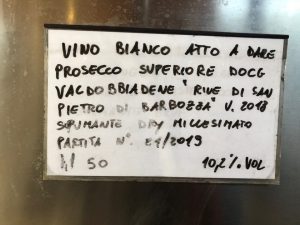Curiosity
How is Prosecco made?

After tidying up the various denominations of Prosecco, many of you might be wondering but …
How is Prosecco made?
The sparkling of the wine is made with the Martinotti method (the autoclave) and there is an official specification that defines all the steps in a very detailed way.
There is a supervisory commission that has the task of checking that all the steps needed to make Prosecco are executed as described in the official specification.
Once the base wine is ready, the winery must define the types of Prosecco it intends to make (Brut, Dry, Extra Dry) and list the “ingredients” (sugar and yeast) it intends to use indicating also types and quantities; the commission must be notify by the winery one week prior moving the wine in autoclave and they need to indicate the precise day and time in which they intend to proceed. On the day agreed at the agreed time, a member of the supervisory commission will be present in the winery to check that all the steps are actually made as previously declared by the winery itself; once everything is verified, the winery gets the ok to proceed with the sparkling process.
If for any reason the winery has to postpone the sparkling process (the sugar is delivered late, the winemaker has a setback…) the commission must be notified and a new appointment established. The winery cannot under any circumstances proceed with the sparkling process without the presence of the vigilant organ.
The autoclave is a pressurized tank that must reach the pressure of 6 atmospheres to obtain the sparkling wine (yes I know this is a so technical … and I’m not good with the technical things so… just trust me!). Once the 6 atmospheres are reached the wine temperature is knocked down to zero degrees; in this way the fermentation process stops, the yeast no longer eats the sugars and it releases instead its softness. The bubbles refines.
Bottling:
Whenever an autoclave of Prosecco (DOC or DOCG as it may be) is ready to be bottled, the winery must notify the fraud prevention commission; a member of the commission physically goes to the winery and takes 7 samples from the autoclave in order to perform the chemical, tasting, visual and olfactory analysis and confirm that the wine in question is aligned with the canons defined for Prosecco. At this point the winery can proceed with bottling.
And now another question arises … How long does it take to make Prosecco?
Very good question!
The wineries that produce mass product are very fast; making the base wine can take 10 to15 days; the sparking process in autoclave can be done in a month and a half so, practically, in 2 , max 2 and a half months the wine is ready for the market.
On the other hand, there are winery that need 3 months to make the base wine (leaving it to rest on the fine lees) and then once in the autoclave, 3 months to reach 6 atmospheres and another 3/4/6 months of aging at zero degrees on the lees to release softness and refine the bubbles.
A mistake that we often make is to think that Prosecco is a young wine that should be drunk immediately and does not age well; it is common believe that if today we buy a 2017 bottle we are buying an old wine … it is not always the case, it is important to understand how that Prosecco is made; if the winery has worked it for over a year, leaving it to age both during the wine making and the sparkling process, it is absolutely normal to buy today a 2017 vintage Prosecco and this Prosecco will last for few years.
If instead the timing between harvest and placing it on the market is 2/3 months … well then yes … it must be drink young!
Some final notes…
Please do not think that all DOCs Prosecco’s are young, made quickly and there for not the best quality, and, that the DOCG are all Prosecco’s of the highest quality; of course, the DOCG Prosecco’s are certainly born in the perfect area and therefor of high quality but there are also some DOCs Prosecco’s that deserve respect!
The advice I can give you? … before buying a Prosecco ask for information …
See you soon
Ciao
Ilde





